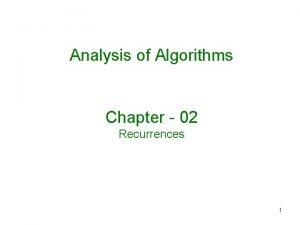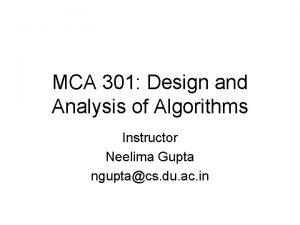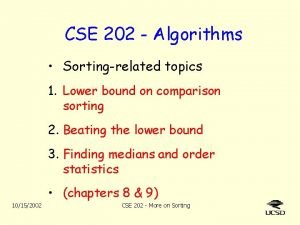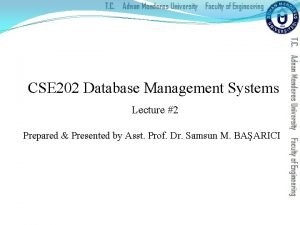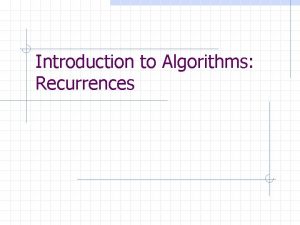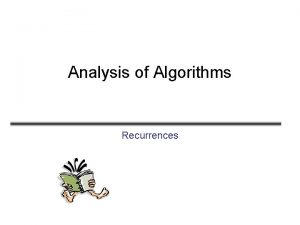CSE 202 Algorithms Recurrences Master Method 482003 CSE








- Slides: 8

CSE 202 - Algorithms • Recurrences • Master Method 4/8/2003 CSE 202 - Recurrences

Your turn. . . For one of the following recursion trees. . . 1. T(n) = 3 T(n/4) + 5 n for n = 256, T(1)=5 2. T(n) = 2 T(n/2) + 5 n for n = 32, T(1)=5 3. T(n) = 3 T(n/2) + 5 n for n = 32, T(1)=5 4. T(n) = 3 T(n/2) + n 2 for n = 32, T(1)=1 5. T(n) = 4 T(n/2) + n 2 for n = 32, T(1)=1 . . . figure out the total “conquer time” (the last term) needed at each level. Answer should be a sequence of 5 or 6 numbers. 2 CSE 202 - Recurrences

Recursion Tree for T(n) = a. T(n/b) + cn cn c n/b . . . c c c . . . a nodes at depth 1 c n/b . . . c n/b 2 c 1 node at depth 0 c n/b 2 . . . c c c a 2 nodes at depth 2 . . . alogbn nodes at depth logb n T(n) = cn+ ac(n/b) + a 2 c(n/b 2) +. . . + alogbnc(n/ blogbn) = cn ( 1 + a/b + (a/b)2 +. . . + (a/b)logbn ). 3 CSE 202 - Recurrences

How does your tree grow? What’s T(n) = cn ( 1 + a/b + (a/b)2 +. . . + (a/b)logbn ) ? The largest term of a geometric series “dominates”. If a/b < 1, the first term dominates Thus, T(n) (n). If a/b > 1, the last term dominates So T(n) (n(a/b)logbn ) = (n(a logbn/blogbn) ) = (n(a logbn/n) ) = (a logbn) = (nlogba). If a/b = 1, all terms are equal. There are log bn terms. So T(n) (n logbn ) = (n lg n). 4 CSE 202 - Recurrences

Where are we ? ? In Divide & Conquer. . . if T(n) = a. T(n/b) + cn, (i. e. if you can combine pieces with linear work) then there are three cases: if a>b, then T(n) is (nlogba) (there are so many tiny subproblems, they dominate the time) if a=b, then T(n) is (n lg n) (just like merge sort) if a<b, then T(n) is (n) (big step is most expensive) 5 CSE 202 - Recurrences

What if combining takes f(n) work? ? In Divide & Conquer. . . if T(n) = a. T(n/b) + f(n), then three corresponding cases are: 1. The tiny subproblems dominate the run time – Happens when f(n) < c a f(n/b) for some c<1 and all n – If so, T(n) (alogbn ) = (nlogba ). 2. All levels take about the same time • Happens when f(n) is (alogbn). • If so, T(n) = (f(n) lg n). 3. Big step is most expensive 6 – Happens when f(n) > c a f(n/b) for some c>1 and all n. – If so, T(n) = (f(n)). CSE 202 - Recurrences

Previous slide is “Master Method” Slight differences: Book’s condition on case 1, “f(n) is O(nlogba- )”, is slightly more general. It allows f(n) to be less uniform. Case 2 – remember alogbn = nlogba. Book has (unnecessary) extra condition in case 3 “f(n) is (nlogba+ )” is implied by “f(n) > c a f(n/b), c>1” Master method can “interpret n/b to mean either n/b or n/b ” 7 CSE 202 - Recurrences

Other recurrences Master Method doesn’t always apply: What if, in Merge. Sort, we divided 75% - 25% ? T(n) = T(3 n/4) + T(n/4) + c n. Or we divided into 1000 and n-1000 sized pieces? T(n) = T(1000) + T(n-1000) + cn (for n>1000). Or consider: T(n) = 2 T(n/2) + n lg n. 8 CSE 202 - Recurrences

